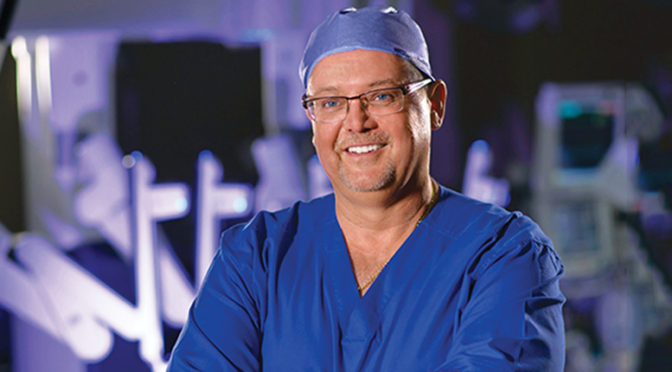Wellington The Magazine-July 2016
Bethesda Hospital West Offers Trusted Kidney Care
Image-guided radiofrequency ablation therapy delivers advanced targeting for many kidney tumors.
Since the mid-1990s, kidney cancer, also called renal cell carcinoma, has been on the rise. According to the American Cancer Society, newer imaging tests are detecting solid renal masses at an earlier stage, partly contributing to the increase in renal cancer diagnoses.
At the same time, however, there has been a marked decrease in death rates from kidney cancer. This welcome news is likely due to improvements in image-guidance technologies that empower radiofrequency ablation (RFA).
RFA is a minimally invasive procedure in which a very thin needle electrode is inserted directly into the tumor’s cancer cells. High-frequency electrical currents pass through the needle, creating heat that destroys cancer cells without harming surrounding healthy tissue.
Specific to a cancerous renal mass, image-guiding technology adds real-time, GPS-like guidance to help a trained radiologist or urologic surgeon place the needle directly into the kidney tumor’s cancer cells, while avoiding healthy tissue.
Bethesda Hospital West is the sole medical institution in Palm Beach County that offers patients one of the most advanced image-guidance technologies, called the Artis Q by Siemens Healthcare, as well as Florida’s only urologic surgeon who performs advanced image-guided RFA for renal cell cancers — Dr. Raymond J. Leveillee, director of the Bethesda Center for Advanced Robotics & Urologic Care.
The Artis Q is a ceiling-mounted X-ray imaging system, with a C-shaped arm that connects to the X-ray source. It is commonly used for interventional angiography or oncology procedures. During the procedure, the patient lies on the specially designed table, and the C-arm is moved to different settings based on the imaging needs.
The quantum leap in this technology relates to a flat-panel detector that rotates around a patient in a two-second sweep, resulting in more efficient, real-time, CT-like medical imaging. There is also greater imaging accuracy when compared to traditional X-ray devices. In addition, the semi-open C-shaped arm gives the radiologist or surgeon more room to work.
An advanced image-guided RFA procedure requires a general anesthesia so that the patient stays perfectly still. “From the patient’s perspective, this therapy is virtually painless,” Leveillee explained. “It’s almost an acupuncture-style approach to solid renal masses.”
With Leveillee’s 15 years of experience in image-guided RFA, he often finds the technique as effective as a partial nephrectomy, the gold standard for treating solid renal masses measuring less than 4 centimeters (about 1.5 inches).
“When it’s the right candidate, image-guided RFA accomplishes the same high level of cancer cure for small renal or kidney masses as cutting the tumor out, but there is a minimal amount of trauma to the patient, virtually no blood loss and maximal preservation of kidney function,” Leveillee said.
Leveillee cites two primary factors for image-guided radiofrequency ablation’s acceptance.
First, enhanced guided-imaging capabilities remove the guesswork as to where the needles should be inserted. With real-time, CT-like imaging, a radiologist or urologic surgeon can see on a monitor precisely where to insert the needles — whether performing a biopsy or targeting cancer cells. With the ability to better target only cancer cells, as much normal tissue as possible can be preserved without compromising the tumor treatment.
“The needles go exactly where I want them, instead of my guessing where they should go and then having to confirm placement with a CT scan,” Leveillee said. “With fewer required CT scans, I reduce the patient’s exposure to radiation.”
Second, a better understanding of candidates for this procedure has increased positive outcomes.
“The proper candidate is somebody with a solid, enhancing renal mass that’s less than four centimeters, which we also refer to as stage T1a,” Leveillee said. “In the past, this therapy, if offered at all, was reserved for elderly patients or those who were not surgical candidates. However, more radiologists and urologic surgeons, like myself, now believe that if the procedure works on someone 75 years old, it will work on someone 65 or 55. So I discuss this option with every qualified patient who comes in the door.”
Recovery from image-guided radiofrequency ablation is quick. “About 98 percent of patients return home the day of the procedure. Within three or four days, patients are off pain medications and back to driving or work,” Leveillee said.
As Bethesda Hospital West continues to stay ahead of the curve in image-guided radiofrequency ablation, Leveillee points to yet another benefit — experience.
“In the early days, there was a higher rate of complications, such as bleeding and obstruction of urine flow from the kidney or skin burns,” he noted. “Those things rarely happen now. We’re selective about choosing the right candidates for this procedure, and we know our limits. That all adds up to improved outcomes, few complications or risks, and high patient satisfaction.”
Bethesda Hospital West is located at 9655 Boynton Beach Blvd. in Boynton Beach. To learn more about the Center for Advanced Robotics & Urologic Care, visit www.bethesdaweb.com or call (561) 737-7733, ext. 84405.
